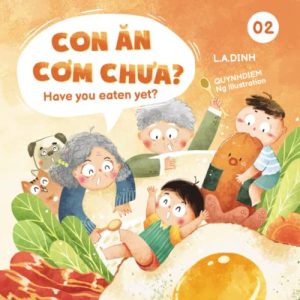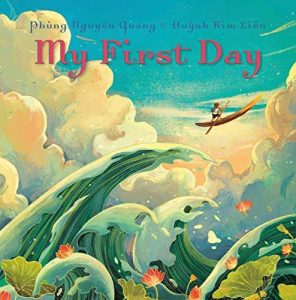Lesson 2: Exploring “Cô Đôi Thượng Ngàn”
Aim: How can we use music to tell stories?
Summary: Students will learn to sing “Cô Đôi Thượng Ngàn,” discuss Vietnamese rhythm, explore tonal language, and create their own Queen of the Forest.
Materials: Musical Explorers digital resources, everyday-object percussion
Standards: GA: ESGMK.PR.1, ESGMK.RE.3, ESGMK.CN.2, ESGM1.PR.1, ESGM1.RE.1, ESGM2.PR.1, ESGM2.RE.1, ESGM2.CN.2
Vocabulary: chorus, tonal language, melodic contour
See Glossary →
- The title of the song “Cô Đôi Thượng Ngàn” literally means “Queen of the Forest,” and it is a Northern Vietnamese folk song that celebrates the Queen of the Forest who rules all of the land.
- In an old Vietnamese tale, the Queen of the Forest was born a princess of the Vietnamese mountain god. Beautiful, powerful, smart, and strong, the princess was chosen by the former queen to be her protégé and taught magic that enabled the princess to take care of those who suffered from sickness. The princess became a beautiful fairy who lived high in the snowcapped mountains and forests, and was responsible for looking after everyone who needed help. Because of her sympathetic heart, she continues to be worshiped as a heroine, spiritual character, and mother to all.
- This song is performed at ceremonies and festivals such as New Year’s celebrations, folk festivals, rituals at temple, or even at home. Wherever it is sung, people pay respect to the Queen of the Forest in between each verse by calling out words and phrases of appreciation for her support and guidance as the spiritual mother of Vietnamese civilization!
Sing “Cô Đôi Thượng Ngàn”
- Listen to “Cô Đôi Thượng Ngàn,” Track 4.07, to hear the full song.
- Listen to the pronunciation of “Cô Đôi Thượng Ngàn” Track 4.08, then learn to sing the melody, Track 4.09.
- Learn to sing the refrain, “Á a a a á à a à à a!” with Track 4.10 then learn the “Cô Đôi Thượng Ngàn” cheering pronunciation, Track 4.11.
- Sing to “Cô Đôi Thượng Ngàn” together.
Track 4.07 – “Cô Đôi Thượng Ngàn”
Track 4.08 – “Cô Đôi Thượng Ngàn” pronunciation
Track 4.09 – “Cô Đôi Thượng Ngàn” melody
Track 4.10 – “Cô Đôi Thượng Ngàn” refrain
Track 4.11 – “Cô Đôi Thượng Ngàn” cheering pronunciation

Cô Đôi Thượng Ngàn
Queen of the Forest
Bài sai đố triệu lục cung,
Nàng ân nàng ái vốn dòng sơn trang
Tính cô hay măng trúc măng giang
Refrain:
Tính tinh tình tinh tính tinh tình.
Á a a a á à a à à a!
Cheering:
Cô ơi, cô đẹp lắm! Cô múa nữa đi cô nhé!
Triều quang sáng tỏ lưng trời
Một mầu xuân sắc tốt tươi rườm rà
Trên ngàn xanh lắm quả nhiều hoa
(Refrain)
(Cheering)
Ngàn xanh lắm quả nhiều hoa
Cô đôi dạo gót vào ra sớm chiều
Chiếc lồ mây nặng trĩu lưng đeo
(Refrain)
The legend has gone on for years
The Mother Goddess is here for us
She takes care of us and is here for us
Refrain:
Tính tinh tình tinh tính tinh tình.
Á a a a á à a à à a!
Cheering:
You are beautiful! Please keep dancing and lead us with you!
The sky is lit up
Spring comes in hundreds of colors
The forest is lush with green
(Refrain)
(Cheering)
The forest brings so many fruits and flowers
Mother Goddess walks around with a basket of food
She comes and gives us life
(Refrain)
Explore Vietnamese Language
Vietnamese is a tonal language. That means that the way you pitch the sounds changes the meaning of the words.
- The Vietnamese language traditionally uses Chữ Nôm, a logographic script, but French occupation lead to the use of the Vietnamese alphabet that is based on the Latin alphabet, like the English alphabet. It uses digraphs and diacritics to mark tones.
- Listen to Track 4.14 to hear Cecilia recite the letters.
- Using the video above hear Cecilia speak the same word, but with a different pitch accented. For example, the Vietnamese word “Bo” can mean many different things depending on the tone.
- As you listen repeat the pronunciations.
Track 4.14 – Vietnamese Alphabet
Creative Extension: Vietnamese Greetings
- In Vietnamese culture it is very important to show respect to one’s elders, whether they are a few or many years older. One of the ways that respect is demonstrated is the use of formal language when addressing someone who is older than you. For example, the way people say “Hello” in Vietnamese depends on how old they are in relation to the person they are greeting. If you visited Vietnam, one of the first questions you may be asked is, “How old are you?” This is so the person speaking to you would know how to politely address you. Here are some examples of formal and informal greetings in Vietnamese:
Xin chào – “Hello” (appropriate for everyone)
Chào – “Hi” (casual hello; only appropriate for people your age or younger)
Chào Chị – “Hello, Madame” (formal, appropriate when speaking to older women)
Chào Chú – “Hello, Sir” (formal, appropriate when speaking to older men)
Chào Zara – “Hi Zar”
Chào meo – “Hi cat”
- Using SG 29 have students, as a class, in pairs, or independently make a list of important people in their lives and identify how they might greet them in Vietnamese. i.e. (parents, siblings, grandparents, teachers, etc.).
Track 4.15 – Vietnamese Greetings
Explore Melodic Contour in “Cô Đôi Thượng Ngàn”
- Vietnamese is a tonal language, which means that each word in the language has a melodic shape that is part of the pronunciation, called its tone. Vietnamese music emphasizes melodic vocal music, and the melodies follow the shape of the language. Melodies can be higher or lower and can rise or fall.
- The traditional music from different regions in Vietnam each have a set of tonal rules expressed through embellishments such as accents, grace notes, and the use of vibrato that shapes the melody.
- In Central Vietnam, the vibrato is wide and slow. In Northern Vietnam, the vibrato is narrow and fast. In Southern Vietnam, the vibrato is narrow, slides in and out of notes, and then lands on a note depending on feeling. These differences help elaborate and emphasize the melody that follows the language’s shape.
- This can include the following types of motion in music:
- Stepwise: The notes move up and down in steps, like a staircase.
- Leaps: The notes jump around, from low to high or high to low.
- Bends: The notes slowly rise and fall with a smooth uninterrupted glide.
- Ascending: The notes start lower and move higher.
- Descending: The notes start higher and move lower.
- Listen to the melody using “Cô Đôi Thượng Ngàn” melody, Track 4.09.
- What kinds of motion in the melody do you hear?
Track 4.09 – “Cô Đôi Thượng Ngàn” melody
What words do you use to describe the contour?
- Use “Cô Đôi Thượng Ngàn” to have your students listen to the subtle differences in “Cô Đôi Thượng Ngàn” during the celebratory refrain “Á a a, a á à a à à a!” which follows each verse.
- Practice singing the line all together along with “Cô Đôi Thượng Ngàn” refrain, Track 4.10.
Track 4.10 – “Cô Đôi Thượng Ngàn” refrain
What shapes do you hear?
- Next, draw the melody on a piece of paper using assorted colors for each verse by following the contour and moving from left to right.
- Experiment with ornamenting and improvising a new line, first by demonstrating for your students and then asking for volunteers to give it a try.
Explore Rhythm in “Cô Đôi Thượng Ngàn”
- “Cô Đôi Thượng Ngàn” has a distinctive underlying rhythm which is like one you would hear in a rock ‘n’ roll song—rare for Vietnamese folk music! This rhythm is generally played on a bass drum made with cow hide and is highly energetic. What makes this rhythm unique is the importance of the different emphasis on each beat:
It emphasizes the upbeat.
It makes the fourth eighth note bouncier than the first three.

Track 4.12 – “Cô Đôi Thượng Ngàn” rhythm track
- Listen to the rhythm using “Cô Đôi Thượng Ngàn” rhythm track, Track 4.12.
- Notice which beats are stronger and which are weaker.
- Next, have the students keep the beat of the bass drum by clapping their hands, patting their laps, or tapping their desks. The downbeat can be with both hands, the third eighth note with the right, and the fourth with the left.
- Once you have the beat down, add in movement. Stand up and clap the rhythm while moving around your classroom.
- Throw your hands up in the air and wave them around on the refrain (“Á a a, a á à a à à a!”)!
- Expand the rhythms by using found percussion at home. Instead of clapping, add percussion to the rhythm while you dance around the room!
Creative Extension: Create Phrases of Appreciation
During ceremonies and festivals, the ceremony master, usually a man, dresses in the clothing of the Queen of the Forest to lead the ceremony. Participants show their appreciation to the Queen by shouting out words and phrases such as “You are very beautiful!” and “Please keep dancing! Keep singing!” in between verses of the song. This tradition makes the ceremony a spiritual and enjoyable one celebrating the Queen of the Forest, showing appreciation to elders, and encouraging one another!
Track 4.13 – “Cô Đôi Thượng Ngàn” appreciation phrases
- Listen to “Cô Đôi Thượng Ngàn” appreciation phrases, Track 4.13, which include phrases of appreciation.
- Have your students speak the phrases together.
- Now, experiment by having your students write down words and phrases of encouragement, appreciation, and thanks.
What words or phrases would you use to encourage celebration?
What words or phrases would you use to show appreciation to the Queen of the Forest?
What words or phrases would you use to say thank you?
- Have your students use their words and phrases by cheering them aloud following each verse and cheering sections of “Cô Đôi Thượng Ngàn” to show appreciation to the Queen of the Forest! They can also improvise their phrases!
Literary Extension: Con Ăn Cơm Chưa? (Have You Eaten Yet?) and My First Day
Con Ăn Cơm Chưa? (Have You Eaten Yet?) by
L. A. Dinh (edited by Hoa Lu Dinh and illustrated QuynhDiem Ng) follows Tom and Teo, two brothers, as they discover cuisine of three regions of Vietnam in their grandparents’ kitchen, learning about manners and Vietnamese food, and leading up to Tết (Lunar New Year).
My First Day by Phùng Nguyên Quang and Huynh Kim Liên tells the story of An, a young Vietnamese boy, who sets out alone on the Mekong Delta in a wooden boat carrying a backpack and single oar to get to his first day of school. On his journey, An is daunted by giant waves, heavy rainfall, and eerie forests. Along his journey, he finds his strength to confront the unknown and complete his journey to his destination.
Musical Word Wall
Add the words chorus, melodic contour, and tonal language to the Musical Word Wall.
See Glossary →
PDF Downloads
Audio Tracks
Track 4.07 – “Cô Đôi Thượng Ngàn”
Track 4.08 – “Cô Đôi Thượng Ngàn” pronunciation
Track 4.09 – “Cô Đôi Thượng Ngàn” melody
Track 4.10 – “Cô Đôi Thượng Ngàn” refrain
Track 4.11 – “Cô Đôi Thượng Ngàn” cheering pronunciation
Track 4.12 – “Cô Đôi Thượng Ngàn” rhythm track
Track 4.13 – “Cô Đôi Thượng Ngàn” appreciation phrases
Track 4.14 – Vietnamese Alphabet
Track 4.15 – Vietnamese Greetings


